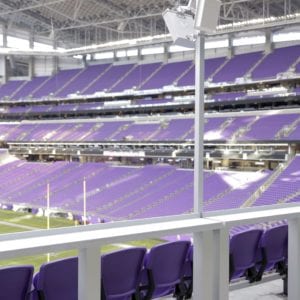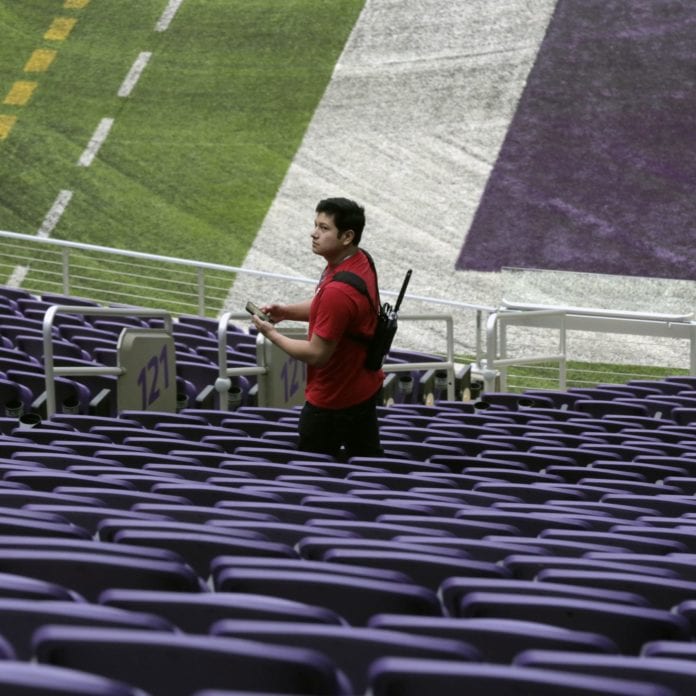The Super Bowl is coming to Minneapolis, and Verizon’s VP of the West is ready — and making sure the carrier’s network is, too.
Mecum is a veteran of cellular network planning for five Super Bowls, and as the New England Patriots take on the Philadelphia Eagles in this weekend’s Super Bowl LII, it is his team who will be ensuring that Verizon’s network is in top condition — not just at the stadium itself, but all around the Minneapolis-St. Paul area, to serve the 1 million visitors who are expected to join in the festivities.
Super Bowl planning, Mecum said, means anticipating a network situation where all devices are powered up and constantly transmitting and receiving, no matter where fans are or what they’re doing. That means both coverage reach — even into enclosed areas like bathrooms — and capacity.
“We have learned that people never stop using their devices,” said Mecum. “I like to joke that there are three things people do during the Super Bowl: They are going to the bathroom, eating, or on their phones — only those three. The usage on their phones never stops … [and] there is no place fans don’t want to use their phones.”
People pay a lot of money to go to the Super Bowl in-person, Mecum noted, and they share that experience on social media: tweeting, uploading pictures or video, and checking other people’s reactions.
“You never take your foot off the gas” for a Super Bowl network, he said — and in the age of unlimited data plans, customers have even higher expectations about access and speed. So a Super Bowl network has to exhibit the best in reliability and ability to handle traffic.
To handle the spike in traffic, Verizon has been working for several years now on permanent infrastructure improvements and stepped up work in the past year to complete everything in time. The carrier doesn’t break out its Super Bowl-specific investments, but has put $612 million into its Minnesota network in the past three years and the Twin Cities are the most populous area of the state. According to the carrier, it has boosted its capacity in the Twin Cities by 500% in preparation for the big game, with permanent improvements including two dozen new cell sites and more than 230 small cells with a focus on popular destinations such as Nicollet Mall. The cold climate means that about four to five months a year are largely off the table for certain work, Mecum said, as the ground freezes and it becomes hard or treacherous to do network installation.
Inside the stadium, there are a number of novel hardware approaches to both coverage and capacity.

Hand-rail and drink-rail antennas have been installed in order to bump up the network density and get closer to users; Verizon said that it increased the stadium antenna density for the DAS by 48%. There are also MatSing ball antennas in use for the first time at an NFL stadium, Mecum said — Verizon had previously only used the massive spheres at outdoor events such as the presidential inauguration and the Indianapolis 500. Those are focused on providing sideline and field coverage and hang 330 feet in the air on a ridge beam. They weigh about 350 pounds apiece, Mecum said, and they will ensure that people on the field itself have good network access — including the game-day photographers who will be transmitting photographs during the event.

But the increases in usage aren’t limited to the stadium itself, or to game day. Verizon is the lead sponsor on the ten-day fan festival Super Bowl Live presented by Verizon (which has already begun), so there’s just a wee bit more pressure that the brand lives up to expectations. Mecum said that the three main venues that Verizon focused on were the stadium, the Mall of America and the airport. The Mall of America will not only see an influx of consumers, Mecum noted, but will also serve as the media center for an expected 5,000 members of the press who will be filing stories, sending photos and posting on social media. Verizon was the lead designer for neutral-host distributed antenna systems in all three locations, Mecum said, where the carrier was expected to work with the other national operators to increase capacity for all.
Asked about the most challenging build, Mecum said that the Mall of America presented the most exacting requirements in terms of aesthetics and scale.
“That was a challenge from a timing perspective, even though we started early,” he said, adding that the level of detail went all the way down to painting the screws on the hardware to match the existing paint just so. “They wanted nothing to stand out, and they’re a great business with high expectations for high quality.”
Editor’s Note: This story has been corrected. An earlier version said that Minneapolis is Mecum’s home town; he lives in California.

